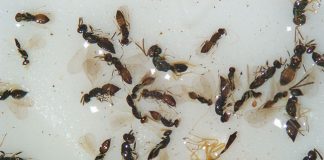This isn’t usually a bad thing, as a second opinion is a good idea unless you know a lot about the subject yourself. I’ve met a farmer who got some really bad advice about his fertilisation, which could have done long-term damage. The physical condition of the soil is most often neglected. We need to monitor the situation under the surface, and there are various tools we can use to do this.
The soil probe
This is a long, thin rod with a handle, and has a specially shaped tip so it can easily be removed once inserted into the soil. It’s made of a high-quality type of spring steel. It’s very useful for a quick soil survey to find compact layers, gravel and stones and to test general compaction. It works with little effort and large areas can be probed fast.
A soil probe is useful for determining the underground conditions when contemplating opening up a new land. It can be used alongside profile holes, to provide a complete picture using fewer holes. It’s also very useful for determining the depth that rain or irrigation has penetrated, as wet soil has less resistance. Soil probes aren’t easy to find these days, but you can get one from Matt Moolman on 011 609 8034.
The soil auger
This tool can do the same work as the probe and more, but with a lot more effort. Unlike the probe, it lets us determine the physical properties of the underlying layers as we bring soil up to the surface. It’s can also take soil samples, particularly for subsoil samples. The auger and probe can be used together. Probe near the auger site so you can both feel and see the conditions. They’re both extremely useful for orchards. I believe augers are readily available. Rather choose a narrow one, which requires less effort and provides the same information.
A garden trowel
For me, walking into a land without a trowel feels like going into town without a wallet! This tool helps us keep in touch with the soil condition in the upper reaches. We can get the feel of the moisture content and relate it to the condition of the leaves, or examine the root zone for disease, eelworm and general health. Prodding a trowel into both good and bad patches helps us correlate conditions that are best for that crop. I far prefer a long, thin, sturdy trowel like the one in the photo. This one is made by Gardena and has served me well for many years and stays in my vehicle.
For orchards or for veg
My first job was working for a large estate where we had to carry a soil tube to determine the orchards’ moisture status. It produced a core of soil which was knocked out and examined, but these seem to have disappeared from the market. There are also gauges which are placed permanently at various depths to determine soil moisture.
They’re great in orchards or with vegetables. They’re perhaps the most useful with carrots, which have a much deeper root system than other veg.We need to know how deep our irrigation penetrates, not just to ensure the crop is well-provided for, but also to prevent leaching of expensive nitrogen. These tools will help you fine-tune your crop production.












